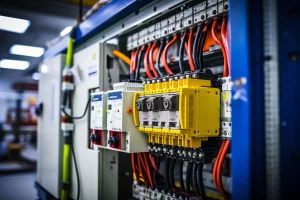In today’s fast-paced industrial landscape, manufacturing plants rely heavily on sophisticated electrical and electronic systems to maintain productivity, efficiency, and safety. Yet, one critical aspect often overlooked is surge protection devices (SPD). While it may seem like a minor investment, the absence of proper surge protection can lead to significant hidden costs, both immediate and long-term, that can cripple operations and drain resources.
What Is Surge Protection?
Surge protection refers to the use of devices and systems designed to shield electrical equipment from voltage spikes or transients. These surges can be caused by lightning strikes, power grid switching, equipment cycling, or even internal sources like motors and compressors. Learn more about types and causes of electrical transients. Without surge protectors, sensitive machinery and control systems are vulnerable to damage, data loss, and operational disruptions.
The Hidden Costs of Ignoring Surge Protection
1. Equipment Damage and Replacement Costs
Voltage spikes can instantly damage or degrade critical components such as PLCs, sensors, drives, and control panels. Replacing these parts is not only expensive but also time-consuming. In high-volume manufacturing environments, even a short downtime for repairs can result in substantial financial losses.
Example: A single surge event damaging a CNC machine controller could cost tens of thousands of dollars in replacement and labour, not to mention lost production time.
2. Unplanned Downtime
Downtime is one of the most expensive consequences of surge-related failures. When equipment fails unexpectedly, production halts, schedules are disrupted, and delivery commitments may be missed. The ripple effect can impact customer satisfaction and long-term business relationships.
According to industry studies, the average cost of unplanned downtime in manufacturing can exceed USD250,000 per hour, which is equivalent to AUD380,000, depending on the scale and complexity of operations.
3. Reduced Equipment Lifespan
Even though surges don’t always cause immediate failure, repeated exposure to transient voltages can slowly degrade internal components, leading to:
- Increased maintenance frequency
- Reduced operational efficiency
- Shortened service life
This hidden wear-and-tear means businesses may need to replace equipment years earlier than expected, undermining long-term investment strategies.
4. Data Loss and System Corruption
Modern industrial systems rely heavily on digital communication and control. Surges can:
- Corrupt firmware or software
- Erase critical operational data
- Disrupt networked systems
Recovery may require specialized IT support, system reconfiguration, and even data reconstruction, which can be both time-consuming and costly.
5. Safety Risks
Surge events can disable or impair safety-critical systems such as:
- Emergency shutdown mechanisms
- Fire detection and suppression systems
- Environmental monitoring controls
This not only endangers personnel but also increases the risk of accidents, regulatory violations, and legal consequences. In industries like chemical processing or food manufacturing, compromised safety systems can be catastrophic.
6. Insurance and Compliance Issues
Many insurance policies require surge protection as part of risk mitigation. Failure to implement adequate protection could result in denied claims or increased premiums. Additionally, regulatory bodies may mandate surge protection for compliance with safety and operational standards.
Why Using Surge Protectors Is a Smart Investment
Implementing surge protection is a proactive strategy that safeguards your assets, ensures operational continuity, and reduces long-term costs. Surge protection devices (SPDs) are relatively inexpensive compared to the potential losses they prevent. They can be installed at various points in the electrical system, from main panels to individual machines, providing layered defence against voltage spikes. Learn more about the different category types of SPDs.
The hidden costs of not integrating surge protectors in manufacturing plants are real and often underestimated. From equipment damage and downtime to safety risks and compliance issues, the financial and operational impact can be severe. Investing in surge protection is not just about preventing damage, it’s about protecting productivity, profitability, and peace of mind.
At Transtech Electronic Controls, we specialize in lightning and surge protection devices, offering solutions such as RJ45 surge protectors, RS485 surge protectors, RS485 lightning protection, lightning and surge protectors, and electrical surge protector devices. Our products ensure uninterrupted system operation and long-term reliability, even in harsh environments.
Don’t wait for a costly surge event to reveal the gaps in your protection strategy. Contact us today to speak with one of our specialists, and we’ll help you to evaluate your facility’s surge protection needs today and take steps to secure your operations for the future.








